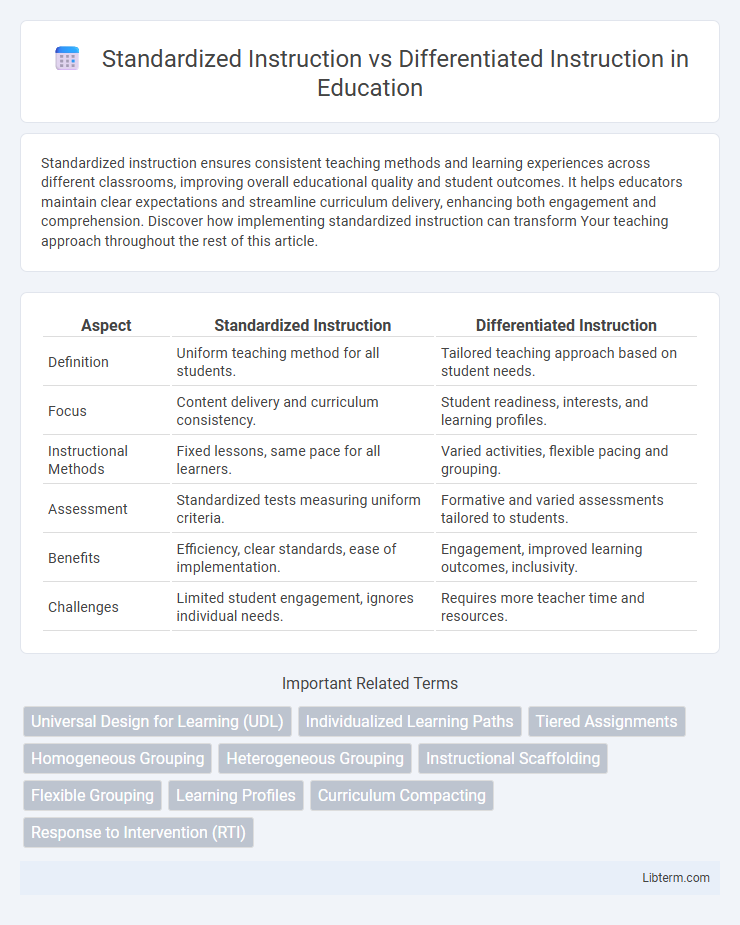Standardized instruction ensures consistent teaching methods and learning experiences across different classrooms, improving overall educational quality and student outcomes. It helps educators maintain clear expectations and streamline curriculum delivery, enhancing both engagement and comprehension. Discover how implementing standardized instruction can transform Your teaching approach throughout the rest of this article.
Table of Comparison
| Aspect | Standardized Instruction | Differentiated Instruction |
|---|---|---|
| Definition | Uniform teaching method for all students. | Tailored teaching approach based on student needs. |
| Focus | Content delivery and curriculum consistency. | Student readiness, interests, and learning profiles. |
| Instructional Methods | Fixed lessons, same pace for all learners. | Varied activities, flexible pacing and grouping. |
| Assessment | Standardized tests measuring uniform criteria. | Formative and varied assessments tailored to students. |
| Benefits | Efficiency, clear standards, ease of implementation. | Engagement, improved learning outcomes, inclusivity. |
| Challenges | Limited student engagement, ignores individual needs. | Requires more teacher time and resources. |
Introduction to Standardized and Differentiated Instruction
Standardized instruction follows a uniform curriculum and assessment method designed to ensure consistency across all learners, typically employing set benchmarks and standardized testing to measure achievement. Differentiated instruction tailors teaching strategies and content to meet diverse student needs, learning styles, and abilities, promoting personalized learning experiences and flexible assessment methods. Both instructional approaches aim to optimize educational outcomes but differ fundamentally in their adaptability and focus on individual learner differences.
Defining Standardized Instruction: Key Features
Standardized instruction involves delivering uniform curriculum and assessments designed to meet consistent educational standards across classrooms, ensuring all students receive the same content and pacing. Key features include a fixed curriculum framework, uniform teaching materials, and standardized testing to measure student performance objectively. This approach emphasizes efficiency, comparability, and accountability in education systems.
Defining Differentiated Instruction: Core Principles
Differentiated instruction centers on tailoring teaching methods, content, and assessment based on student readiness, interests, and learning profiles to maximize individual growth. Core principles include flexible grouping, ongoing assessment, and adaptive pacing to meet diverse learner needs effectively. This approach contrasts standardized instruction by prioritizing personalized learning experiences over uniform content delivery.
Historical Perspectives on Instructional Methods
Standardized instruction, rooted in the early 20th-century rise of industrial education, emphasizes uniformity and efficiency in teaching methods aligned with mass schooling goals. Differentiated instruction emerged in the late 20th century as educators recognized diverse learner needs, advocating personalized strategies based on individual readiness, interests, and learning profiles. Historical shifts reflect broader societal changes, moving from a one-size-fits-all approach toward inclusive education that values student-centered learning and multiple intelligences.
Benefits of Standardized Instruction in the Classroom
Standardized instruction provides a consistent and uniform educational experience, ensuring that all students receive the same foundational knowledge and meet established learning benchmarks. This approach facilitates straightforward assessment and comparison of student performance across diverse classrooms, aiding in curriculum alignment and resource allocation. Classroom management becomes more efficient as standardized materials and pacing create predictable routines, allowing teachers to focus on delivering content effectively.
Advantages of Differentiated Instruction for Diverse Learners
Differentiated instruction offers tailored learning experiences that address the unique needs, strengths, and interests of diverse learners, enhancing engagement and comprehension. It promotes inclusive education by accommodating varying learning styles, paces, and abilities, which leads to improved academic outcomes and increased student motivation. Unlike standardized instruction, differentiated approaches foster a supportive environment that encourages critical thinking and personal growth among all students.
Challenges of Implementing Standardized Instruction
Standardized instruction faces challenges such as limited flexibility to address diverse learning styles and varying student needs, often resulting in disengagement and reduced academic performance. The rigid curriculum and assessment methods can undermine teacher autonomy and hinder the ability to personalize learning experiences. Resource constraints and resistance to change from educators further complicate effective implementation of standardized instructional models.
Obstacles in Adopting Differentiated Instruction
Obstacles in adopting differentiated instruction include limited teacher training, which hampers educators' ability to design and implement varied lesson plans effectively. Time constraints and large class sizes further challenge personalized learning approaches, making it difficult to address diverse student needs. Additionally, lack of administrative support and insufficient resources often prevent schools from fully integrating differentiated strategies into standard curricula.
Comparing Outcomes: Student Achievement and Engagement
Standardized instruction offers uniform curriculum and assessments, often resulting in consistent achievement data but limited student engagement due to a one-size-fits-all approach. Differentiated instruction tailors teaching methods and materials to individual learner needs, boosting student engagement and typically leading to higher achievement by addressing diverse learning styles. Research indicates differentiated instruction improves critical thinking and retention, while standardized instruction may fail to address gaps for struggling students.
Choosing the Right Approach: Factors for Educators to Consider
Choosing between standardized instruction and differentiated instruction hinges on student diversity, learning objectives, and resource availability. Standardized instruction benefits large groups with uniform content delivery, while differentiated instruction caters to varied learning styles, abilities, and interests, promoting engagement and mastery. Educators must evaluate class size, curriculum goals, assessment methods, and individual student needs to determine the most effective approach for maximizing educational outcomes.
Standardized Instruction Infographic

 libterm.com
libterm.com